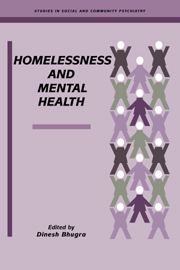Book contents
- Frontmatter
- Contents
- List of contributors
- Preface
- Part I INTRODCTION AND SPECIAL GROUPS
- 1 Introduction
- 2 Homelessness and mental illness: a brief history
- 3 Models of homelessness
- 4 Young homeless and homeless families: a review
- 5 Homeless women
- 6 Homelessness and criminality
- Part II SERVICES
- Part III INTERNATIONAL PERSPECTIVE
- Part IV POLICY AND EVALUATION
- Index
1 - Introduction
from Part I - INTRODCTION AND SPECIAL GROUPS
Published online by Cambridge University Press: 15 October 2009
- Frontmatter
- Contents
- List of contributors
- Preface
- Part I INTRODCTION AND SPECIAL GROUPS
- 1 Introduction
- 2 Homelessness and mental illness: a brief history
- 3 Models of homelessness
- 4 Young homeless and homeless families: a review
- 5 Homeless women
- 6 Homelessness and criminality
- Part II SERVICES
- Part III INTERNATIONAL PERSPECTIVE
- Part IV POLICY AND EVALUATION
- Index
Summary
Homelessness and its consequences have become much more visible on the streets of big cities as well as villages across the globe in the last few years. In the UK this has been linked with the policy of closing psychiatric hospitals because there is often a clear association between mental illness and homelessness, though the direction of such an association may not always be very obvious. Across the world, experiences of poverty, homelessness and mental illness are universal. However, the definitions of homelessness, expectations from the government of the day and the availability of mental health services all play a role in the visibility of the homeless mentally ill on the streets. A large volume of literature on the homeless mentally ill exists in the USA. The availability of information from our European partners remains somewhat limited, especially in English. The work on urbanization and mental illness focuses on the internal migration to big cities in the developing countries. However, the impact of rapid industrialization, increasing populations and limited availability of land and cheap housing make overcrowding with its resultant problems a real issue. The impact of these factors varies across nations and societies. Even though the ideas and reality of homelessness are not entirely new, their increased visibility in the bright lights of the city means that across the globe similar experiences are beginning to emerge. The universal confusion about the definitions of homelessness makes it essential to try to get an international perspective. Internal migration, unemployment, closure of casual accommodation and disinvestment in public housing appear to be some of the international themes.
- Type
- Chapter
- Information
- Homelessness and Mental Health , pp. 3 - 10Publisher: Cambridge University PressPrint publication year: 1996

